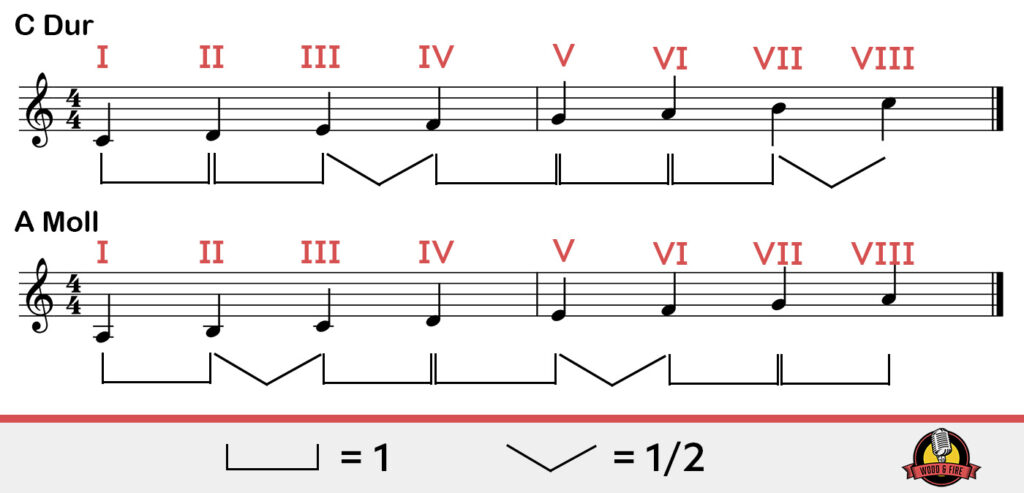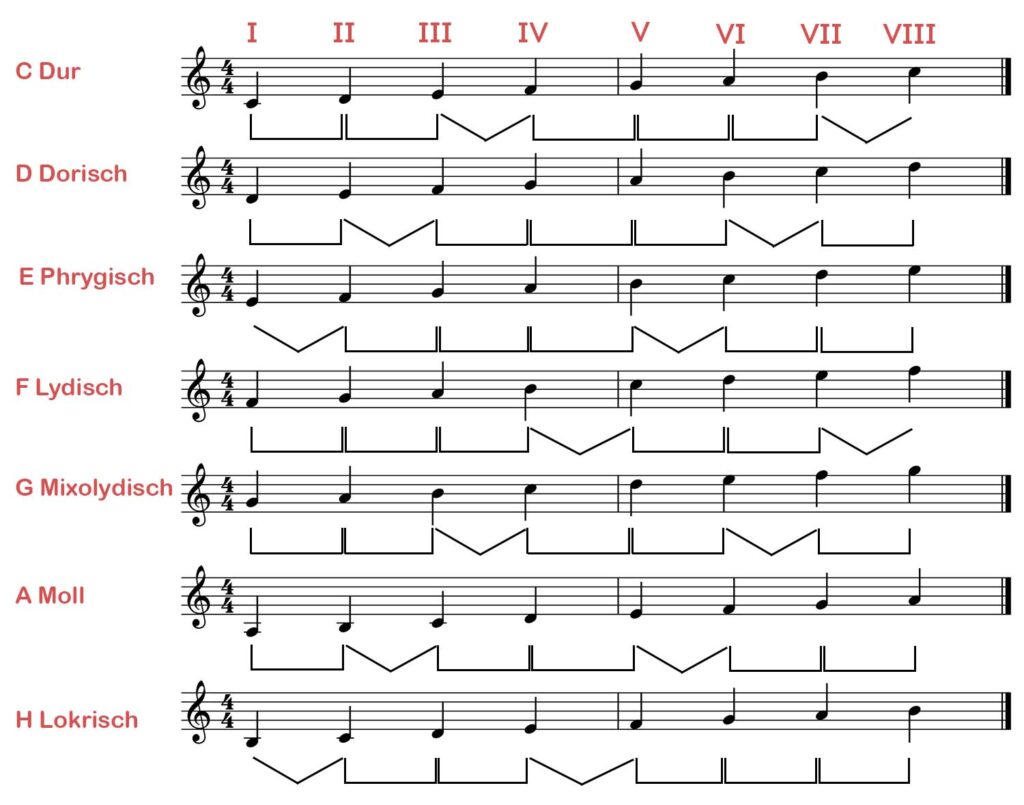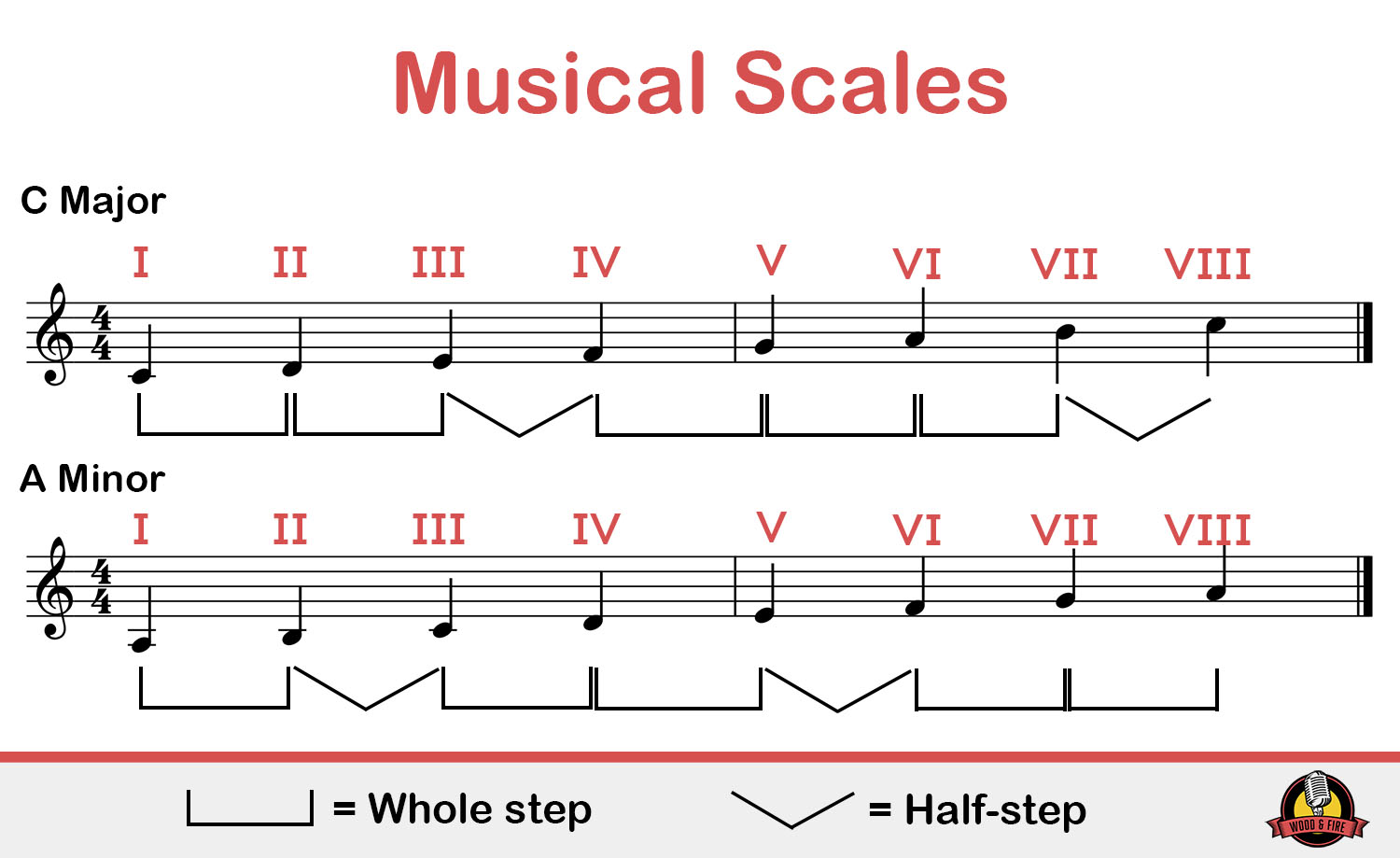What is a scale?
In music theory, a scale is a sequence of notes within an octave, where the last note is a repetition of the first note exactly one octave higher. Scales can be ascending (notes go from bottom to top) or descending (notes go from top to bottom).
There are different scales which are characterized by certain intervals between the individual notes. In modern Western music, scales always have whole tone and half-tone intervals as steps within the scale. Depending on which step the semitone intervals are on, the scale takes on a different character and name. The most common scales used in Western music are the major scale and the minor scale.
You can learn more about this in my extensive article about intervals and their names.
Every scale has a fundamental (also called the tonic). It gives the scale its name and is the first note. So if you play an A minor scale, the first note is always an A.
As an example, consider the two most common scales in Western music, C major and A minor. They are so popular because they are the easiest to play, since they have no accidentals in their key signature.

The C major scale consists of the notes C, D, E, F, G, A, and B. Accordingly, the intervals within the scale are as follows: tone - tone - semitone - tone - tone - tone - semitone.

The A minor scale consists of the same notes, but in a different order: A, B, C, D, E, F, G. The intervals are accordingly as follows: tone - semitone - tone - tone - semitone - tone - tone.
History of scales
The history of scales in music dates back to antiquity and has evolved over millennia in many cultures around the world. Ancient Greece is often our first stop when thinking about the beginnings of music theory. Here, philosophers like Pythagoras experimented with mathematical relationships between tones.
They spoke of "tetrachords," four-note chords that formed the basis of their musical theories. These tetrachords served as building blocks for larger musical systems and laid the foundation for later musical developments.
In the Middle Ages, a time of the spread of Christianity and the emergence of Gregorian chant, the Church began to develop its own musical modes. These clerical modes were the forerunners of our modern scales, which were further standardized during the Renaissance and Baroque periods. At that time they were called the Ionian and Aeolian scales, but they were identical to our modern major and minor scales.
These eras also saw the introduction of equal temperament, an innovation that aided the rise of the modern piano and made it easier to play in different keys.
But the Western tradition is only part of the story of scales. Cultures around the world have developed their own musical systems, from the ragas of Indian music to the pentatonics of the Chinese tradition to the maqams of the Arab world.
In the modern era, particularly in the 20th century, the emergence of genres such as jazz and electronic music saw a reevaluation and innovative use of scales. Although it is difficult to pinpoint the exact origin of scales, their deep-rooted history in human culture is undeniable.
Structure of a heptatonic scale
The heptatonic scale is the most important scale in Western music. They consist of 7 tones, hence the name ("hepta" is Greek and means seven). Usually, however, eight tones are played, with the eighth tone being the same as the first, but an octave higher.
In total, a heptatonic scale has 5 whole steps and 2 half steps. Depending on where the intervals lie, the scale has a different mode. For example, the minor scale has the half steps between the second and third degree and between the fifth and sixth degree, while the major scale has the half steps between the third and fourth degree and between the seventh and eighth degree.

Here are the 7 common heptatonic scales (also known as church scales):
- Ionic (Natural Major): This is the ordinary major scale. For example: C-D-E-F-G-A-B-C
- Doric: A minor scale with an augmented 6th note. For example: D-E-F-G-A-B-C-D
- Phrygian: A minor scale with a diminished 2nd note. For example: E-F-G-A-B-C-D-E
- Lydian: A major scale with an augmented 4th note. For example: F-G-A-B-C-D-E-F
- Mixolydian: A major scale with a diminished 7th note. For example: G-A-B-C-D-E-F-G
- Aeolian (Natural minor): This is the ordinary minor scale. For example: A-B-C-D-E-F-G-A
- Locrian: A minor scale with a diminished 2nd and 5th note. For example: B-C-D-E-F-G-A-B
These seven scales are modes of the diatonic scale and are commonly used in Western music. However, there are many other heptatonic scales in various musical cultures and traditions around the world. In some musical systems, microtonalities or more complex interval structures (augmented seconds) can be used to create unique heptatonic patterns.
Natural major scale
➔ Click here to read the full article on the major scales

Major scales are the most important scales of all. They are always learned first in music and instrumental lessons because they form the basis for many harmonic structures. The interval structure of a major scale is: whole step - whole step - half-step - whole step - whole step - whole step - half-step.
The major scale can be formed from the note C by playing all the basic notes (white keys on the piano). That is, starting from the note C, the sequence of notes C-D-E-F-G-A-B-C results in the C major scale.
In music theory, major scales are known for their "happy" or "positive" sound qualities and are therefore very suitable for happy songs.
Natural minor scale

Minor scales are the second most important type of scale in Western music theory after major scales. They have a characteristic interval structure that gives them a "sadder" or "darker" sound than the "brighter" or "happier" major scales.
There are several types of minor scales, but the most common and well-known is the natural minor scale. The interval structure of the natural minor scale is as follows: whole step - half-step - whole step - whole step - half-step - whole step - whole step
If you play out all the root notes of A, you get the natural A minor scale, which contains neither b's nor crosses: A-B-C-D-E-F-G-A
Doric scale

The Dorian scale is one of the seven church keys (or modes) of the diatonic scale, not as commonly used as the major or minor scales, but with a unique character. The Dorian scale has the following interval structure:
Whole step - half step - whole step - whole step - whole step - half step - whole step
In modern music the Dorian scale is often referred to as a minor scale with a major sixth. If we look at the Dorian scale from D (since there are no sharps or flats in this key), it looks like this: D - E - F - G - A - B - C - D.
An essential feature of the Dorian scale compared to the natural minor scale is the presence of the augmented sixth degree. This gives it a slightly less "sad" timbre than the natural minor scale.
The Dorian scale is often considered a bit "jazzier" or "cooler" than the natural minor scale. It is used in many styles of music, especially jazz, fusion and rock, and can be an interesting alternative to the traditional minor scale.
Phrygian scale

The Phrygian scale is also one of the seven modes of the diatonic scale in Western music theory. This mode is best known for its characteristic diminished second note, which gives it an exotic or "oriental" sound.
The interval structure of the phrygian scale is as follows: Half step - whole step - whole step - whole step - half step - whole step - whole step
If you start from E and use only the white keys of a piano, the sequence of notes E-F-G-A-B-C-D-E gives the E phrygian scale.
The Phrygian scale is often used in various styles of music, especially flamenco and oriental music, to create a dark, mysterious or exotic sound. The diminished second degree gives the Phrygian scale a tension and drama that distinguishes it from other modes.
Lydian scale

Starting from F and using only the white keys of a piano, the sequence of notes F-G-A-B-C-D-E-F results in the F-lydic scale. Its characteristic feature is the augmented fourth, which gives this scale a distinctive "floating" or "ethereal" sound.
The interval structure of the Lydian scale is: Whole step - whole step - whole step - half step - whole step - whole step - half step
The Lydian scale is often used to create a dreamlike, celestial, or mystical sound in music. This is mainly due to the exaggerated fourth note, which breaks the typical structure of the major scale and creates an unexpected and striking sound. In many contexts, especially in film and television scoring, the Lydian scale can be used to create feelings of wonder, enchantment, or majesty.
Mixolydian scale

The mixolydian scale is a special kind of major scale with the peculiarity of the diminished seventh degree, which makes it different from the conventional major scale.
The interval structure of the mixolydian scale is as follows: Whole step - whole step - half step - whole step - whole step - half step - whole step
If you start from G and use only the white keys of a piano, the sequence of notes G-A-B-C-D-E-F-G results in the G-mixolydian scale.
The mixolydian scale is often associated with a "bluesy" sound because the diminished seventh gives the sound a certain melancholy and "dirtiness" that is different from the pure major scale. This is why this scale is often used in blues guitar solos, since it always corresponds exactly to the notes of the dominant of the key (hence the name dominant scale).
Locrian scale

The Locrian scale, or Locrian mode, is the seventh and last of the modes of the diatonic scale in Western music theory. The Locrian mode is particularly noteworthy because it is the only diatonic mode with a diminished fifth (Tritonus). This tone gives it a particularly dissonant and unsteady sound.
The interval structure of the locrian scale is: Half step - whole step - whole step - half step - whole step - whole step - whole step
Starting with the note B and using only the white keys of a piano, the sequence of notes B-C-D-E-F-G-A-B results in the locrian scale of B.
Because of its unstable sound, the locrian scale is not often used as the basis for an entire piece of music. However, it is used in certain jazzy or experimental contexts, especially when a particularly tense or "dark" sound is desired. The diminished fifth (tritone) is one of the most dissonant intervals in music, which gives the Locrian scale its unique, dark character.
Here you can see all the church scales overlaid. This gives you an overview of the semitones of each scale:

Pentatonic scale
➔ Click here to read the full article on the pentatonic scales.
Pentatonic scales are five-note scales used in many musical cultures around the world. They often have a simpler and more open sound quality, and because they contain fewer notes, they avoid many of the harmonic and melodic complexities of heptatonic scales. As a result, they create no tension and therefore no need for resolution.
In Western music, two types of pentatonic scales are particularly common: the major pentatonic and the minor pentatonic.

Pentatonic major scale: This scale is made up of the notes 1, 2, 3, 5 and 6 of the diatonic major scale. Example in C major: C-D-E-G-A.
Folk, country and other genres that prefer a simpler and more melodic approach often use it.

Pentatonic minor scale: This scale is made up of the notes 1, 3, 4, 5 and 7 of the diatonic minor scale. Example in A minor: A-C-D-E-G
The minor pentatonic scale, often with an additional "blues tone" (the semitone between the 4th and 5th degrees), is especially common in blues and rock music, and forms the basis for many guitar solos in these genres.
Gypsy scale
The term "gypsy scale" is often used to describe a group of scales that produce characteristic sounds associated with Roma music. They are mainly characterized by excessive second steps, which give them a unique character. They are mainly used in Spanish flamenco and Arabic music.
There are several scales that fall under the term "gypsy scale", but two of the most popular are the gypsy minor and the gypsy major.
Gypsy minor

The gypsy minor scale, also known as the Hungarian scale, consists of a simple minor scale with the fourth and seventh degrees raised. This results in the following interval steps: whole step - half step - 1½ step - half step - half step - 1½ step - half step.
On A, these would be the notes A - B - C - D sharp - E - F - G sharp - A. The two augmented seconds create a special oriental character.
A good example of the gypsy minor scale is the song "Musterion" by Joe Satriani, in which the guitar plays a solo over this scale.

By loading the video, you accept YouTube's privacy policy.
Learn more
Gypsy Major

The gypsy major scale is also called the Arabic scale because it is found primarily in Arabic music. It consists of a simple major scale with diminished second and sixth degrees. This creates augmented seconds between the second and third degrees and between the sixth and seventh degrees.
The interval steps are as follows: half step - 1½ step - half step - whole step - half step - 1½ step - half step. On C, these would be the notes C - D flat - E - F - G - A flat - B - C.
This scale can be heard very well in the song "Gates of Babylon" by Rainbow, which also gets a very exotic touch from it:

By loading the video, you accept YouTube's privacy policy.
Learn more
Learning scales
Learning scales is a fundamental part of musical education and offers many benefits no matter what level you are at as a musician. They will help you take your compositions to a higher level because you will be able to use different scales in your chord progressions if you know where and how to use them.
Why should you learn scales?
Especially as a beginner, you often don't really understand why you should learn the different scales in music lessons. Even if the benefits are not immediately obvious, having a basic knowledge of scales is a huge advantage.
- Technique and skill: Regular practice of scales improves dexterity and technique on the instrument, whether keyboard, wind or string.
- Understanding music theory: Scales are the basis for harmonies, chord structures, and many melodies. Understanding scales helps you see music in context and apply this knowledge to your own compositions.
- Intonation and ear training: It is important for singers and instrumentalists to hit pitches correctly. Practicing scales promotes intonation accuracy.
- Improvisation: Understanding the structure of scales makes it easier to improvise melody lines and phrases, especially in genres like jazz, blues, and rock. Because you know which scales you can try and when, without the notes sounding "off" or "out of tune".
- Versatility: Knowing different scales, especially exotic scales, expands your musical vocabulary and allows you to play in different styles and genres while remaining creative and imaginative.
What is the best way to practice scales?
You need a mix of patience, strategy and creativity. In the beginning, try to play the notes of the scale slowly from bottom to top and from top to bottom on your instrument. The speed can always be increased later, but first it is important to play each note cleanly and correctly.
The use of a metronome, a timed guide, can work wonders in maintaining a steady rhythm. It is also worth studying different finger positions, especially on keyboard instruments, to find the most efficient movements for each scale.
Variety is also important to avoid boredom. Practicing in different octaves or experimenting with different patterns and sequences can make practicing both challenging and fun. Ultimately, learning should never be done in isolation from application. I always recommend playing pieces or songs that use the newly learned scale to put what you have learned into a real musical context.
As in many areas of life, regular practice and dedication pays off in music. Learning scales can be a daunting task at first, but the rewards in terms of technical brilliance, musical understanding, and creative expression are well worth the time invested.
















